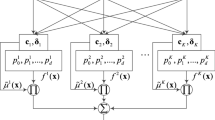Abstract
In case of decision making problems, identification of nonlinear systems is an important issue. Identification of nonlinear systems using a multilayer perceptron (MLP) trained with back propagation becomes much complex with an increase in number of input data, number of layers, number of nodes, and number of iterations in computation. In this paper, an attempt has been made to use fuzzy MLP and its learning algorithm for identification of nonlinear system. The fuzzy MLP and its training algorithm which allows to accelerate a process of training, which exceeds in comparison with classical MLP is proposed. Results show a sharp reduction in search for optimal parameters of a neuro fuzzy model as compared to the classical MLP. A training performance comparison has been carried out between MLP and the proposed fuzzy-MLP model. The time and space complexities of the algorithms have been analyzed. It is observed that the number of epochs has sharply reduced and performance increased compared with classical MLP.
Similar content being viewed by others
References
V. Borisov, V. Kruglov, and A. Fedulov, Fuzzy Models and Nets [in Russian], Goryachaya Liniya—Telekom, Moscow (2012).
A. I. Galushkin, Neural Networks Theory, Springer-Verlag, Berlin–Heidelberg (2007).
S. Haykin, Neural Networks. A Comprehensive Foundation. 2nd ed., IEEE, New York (1999).
K. M. Jose and M. A. Fabio, “Nonlinear system identification based on modified ANFIS,” Proc. 2015 12th Int. Conf. on Informatics in Control, Automation and Robotics (ICINCO), Colmar, France, 21–23 July 2015, Colmar, pp. 588–595 (2015).
Y. I. Mityushkin, B. I. Mokin, and A. P. Rotshtein, Soft Computing: Identification of Dependencies with Fuzzy Knowledge Bases [in Russian], Universum, Vinntitsa (2002).
A. Nikov and T. Georgiev, “A fuzzy neural network and its matlab simulation,” Proc. ITI99 21st Int. Conf. on Information Technology Interfaces, Pula, Croatia, June 15–18, Pula, pp. 413–418 (1999).
A. Pegat, Fuzzy Modelling and Control [in Russian], BINOM. Laboratoriya znaniy, Moscow (2013).
M. Qing-Song, “Approximation ability of regular fuzzy neural networks to fuzzy-valued functions in MS convergence structure,” Proc. 32nd Chinese Control Conf., Xian, China, 26–28 July 2013, Xian, INSPEC Acc. Num. 13862419 (2013).
B. P. Rakesh and K. Sh. Satish, “Identification of nonlinear system using computational paradigms,” Proc. Int. Conf. on Automatic Control and Artificial Intelligence, Xiamen, China, 3–5 March 2012, Xiamen, pp. 1156–1159 (2012).
A. P. Rotshtein, “Design and tuning of fuzzy if–then rules for medical diagnosis,” In: Fuzzy and Neural-Fuzzy Systems in Medical and Biomedical Engineering, CRC Press, Boca-Raton, pp. 243–289 (1998).
A. P. Rotshtein and Y. I. Mityushkin, “Extraction of fuzzy rules from experimental data using genetic algorithms,” Cybernet. Systems Anal., No. 3., 45–53 (2001).
A. P. Rotshtein and S. D. Shtovba, “Identification of nonlinear dependencies of fuzzy knowledge bases with fuzzy learning inputs,” Cybernet. Systems Anal., No. 2, 17–24 (2006).
D. E. Rumelhart, G. E. Hinton, and R. J. Williams, “Learning internal representations by backpropagating errors,” Nature, 323, 533–536 (1986).
S. D. Shtovba, Design of Fuzzy Systems by Means of MATLAB [in Russian], Goryachaya Liniya—Telekom, Moscow (2007).
H. J. Zimmermann, Fuzzy Set Theory and Its Applications, Kluwer, Dordrecht–Boston (1991).
Z. Zongyuan, X. Shuxiang, H. K. Byeong, M. Mir, L. Yunling, and W. Rainer, “Investigation and improvement of multilayer perceptron neural networks for credit scoring,” Expert Syst. Appl., 42, No. 7, 3508–3516 (2015).
Author information
Authors and Affiliations
Corresponding author
Additional information
Translated from Sovremennaya Matematika. Fundamental’nye Napravleniya (Contemporary Mathematics. Fundamental Directions), Vol. 65, No. 1, Contemporary Problems in Mathematics and Physics, 2019.
Rights and permissions
Springer Nature or its licensor holds exclusive rights to this article under a publishing agreement with the author(s) or other rightsholder(s); author self-archiving of the accepted manuscript version of this article is solely governed by the terms of such publishing agreement and applicable law.
About this article
Cite this article
Marakhimov, A.R., Khudaybergenov, K.K. A Fuzzy MLP Approach for Nonlinear System Identification. J Math Sci 265, 43–51 (2022). https://doi.org/10.1007/s10958-022-06043-z
Published:
Issue Date:
DOI: https://doi.org/10.1007/s10958-022-06043-z




